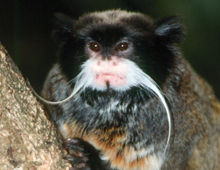Flooded Forest

Plate-billed mountain toucan, Andigena laminrostris
Not seen in collections until the 1960s, this strangely beautiful bird from the cool Andean forests of Colombia and Ecuador was kept by a number of places in the 1970s and ’80s, and several were hatched. Today it is rare in captivity, but the DWA has recently been repeatedly propagating it. Because its mountain habitat continues to disappear, it is considered Near Threatened.
LEARN MORE
Emperor tamarin, Saguinus imperator imperator
Of the two subspecies of Emperor tamarins, this one, with a dark tail and no beard, is the less common in captivity. It is found in a small area of Brazil and Peru. Like other tamarins, the male takes care of the twins (the most common sort of birth), giving them to the female only to nurse. They usually stay with their family group (led by a dominant female) for around two years.
LEARN MORE
Electric eel, Electrophorus electricus
Not related to saltwater or migratory eels, this South American fish has an elegantly minimal method of moving through water. This is mostly achieved by a parabolic wave generated through the long ventral fin. The tiny pectoral fins may steer. Most of the body is taken up by electricity generating tissue. An adult may produce a 500-watt charge. The digestive and reproductive organs are confined to a small area just behind the head. Exhibited at New York’s Central Park Zoo more than a century ago, it has long been a popular aquarium display.
LEARN MORE
Yellow-spotted Amazon turtle, Podocnemis unifilis
In the 1960s, vast numbers of the tiny, brightly colored young of this species were sent to the US with shipments of tropical fish, but most did not survive. Since females may exceed 17 inches in shell length, they are not appropriate for most home aquariums. Serious private collectors and zoos have done well with them, and they have bred many times in captivity. While considered vulnerable to extinction, they remain an important resource for Native Americans in parts of their wide South American range.
LEARN MORE
Silver arowana, Osteoglossum bicirrhosum
Though the Silver and Black arowanas of South America, and the Asian and Australian arowanas resemble each other, and share the behavior of brooding their eggs and fry in their mouths, they last shared a common ancestor around 170 million years ago, when the great Southern Continent Gondwana began to split apart. This took place in the Jurassic period, when dinosaurs still thrived. Although Asian arowanas are endangered, South American ones are abundant, and are important both to subsistence fishing and the sustainable aquarium trade.
LEARN MORE

